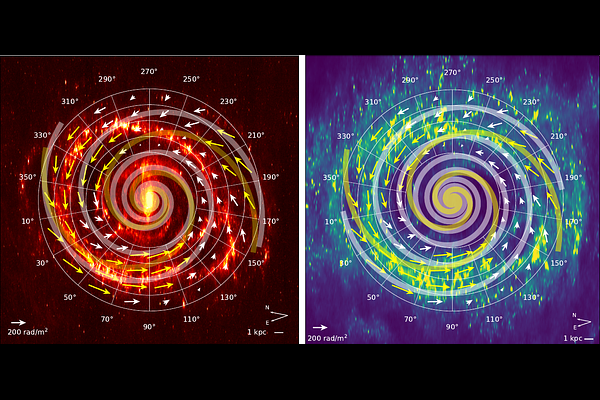The fine structure of the mean magnetic field in M31

The fine structure of the mean magnetic field in M31
Indrajit Paul, R. Vasanth Kashyap, Tuhin Ghosh, Rainer Beck, Luke Chamandy, Srijita Sinha, Anvar Shukurov
AbstractTo explore the spatial variations of the regular (mean) magnetic field of the Andromeda galaxy (M31), we use Fourier analysis in azimuthal angle along four rings in the galaxy's plane. Earlier analyses indicated that the axisymmetric magnetic field (azimuthal Fourier mode $m=0$) is sufficient to fit the observed polarization angles in a wide range of galactocentric distances. We apply a Bayesian inference approach to new, more sensitive radio continuum data at $\lambda \lambda3.59$, $6.18$, and $11.33$ cm and the earlier data at $\lambda 20.46$ cm to reveal sub-dominant contributions from the modes $m=1$, 2, and 3 along with a dominant axisymmetric mode. Magnetic lines of the axisymmetric mode are close to trailing logarithmic spirals which are significantly more open than the spiral arms detectable in the interstellar dust and neutral hydrogen. The form of the $m=0$ mode is consistent with galactic dynamo theory. Both the amplitudes and the pitch angles of the higher azimuthal modes ($m>1$) vary irregularly with $r$ reflecting local variations in the magnetic field structure. The maximum strength of the mean magnetic field of $1.8\text{--}2.7\mu$G (for the axisymmetric part of the field) occurs at $10\text{--}14$ kpc but we find that its strength varies strongly along the azimuth; this variation gives rise to the $m=1$ mode. We suggest a procedure of Bayesian inference which is independent of the specific nature of the depolarization and applies when the magneto-ionic layer observable in polarized emission is not symmetric along the line of sight because emission from its far side is completely depolarized.